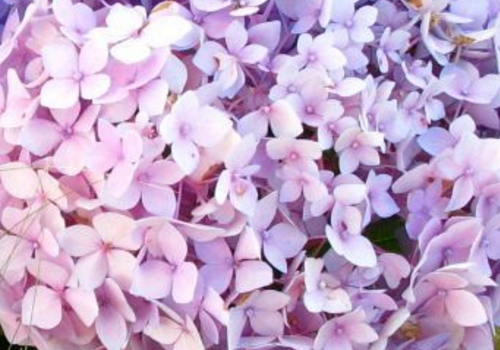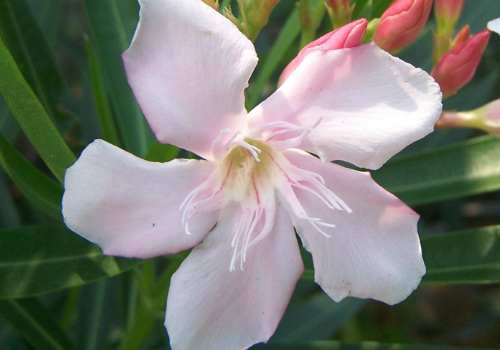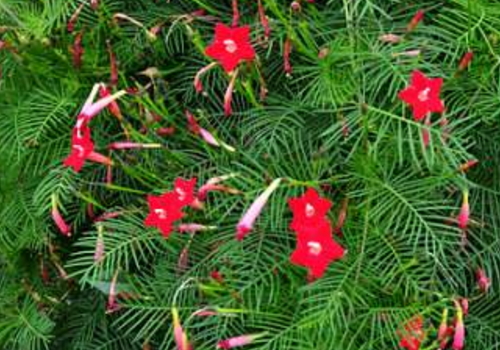Why Hydrangea doesn't bloom? what are the varieties of hydrangea?
Hydrangea flowers, I believe many people have seen, is very beautiful. Why don't hydrangeas bloom? What varieties do you have?
Why doesn't hydrangea blossom:
1. Potted hydrangea has not been pruned.
It is usually necessary to cut the tip of the branch in time after the flower fade to promote the division of new branches. when the new branch grows to 8-10 cm, it can be cut short again, which can promote the lateral bud on it to develop and enrich as soon as possible, so that it can grow flower branches in the following year; that is to say, through topping to inhibit the vegetative growth of the plant, to promote its multiple lateral branches, pregnant flower buds.
2. The proportion of fertilization of hydrangea is out of proportion.
It is possible that there is too much nitrogen fertilizer and less phosphorus and potassium fertilizer, resulting in its vegetative growth is too prosperous, so it is not conducive to flower bud gestation, so that the plant can not bloom normally in the second and third year.
3. It may be because of too much watering.
When the new shoot of the plant grows to a certain length, it is necessary to give appropriate "buckle water" to inhibit its vegetative growth and promote flower bud differentiation.
4. The control of lighting time is not appropriate.
Hydrangea is a short-day plant that remains dark for more than 10 hours a day and takes about 6 weeks to form flower buds. After 6-8 weeks of cool (5-7 ℃), the plant was placed at a temperature of 20 ℃ to promote flowering. When the inflorescence could be seen, the temperature was reduced to about 16 ℃, so that it could blossom for about 2 weeks.

What are the varieties of hydrangea:
Flamboant: the leaves are small, the flowers are large and magenta, and the flower diameter is 5 cm.
Snowball: leaves small, jagged, normal flowers rose red, can turn blue. Treated with aluminum sulfate, it can turn into sky blue and beige flower hearts.
French hydrangea: magenta or rose red flowers can be changed to blue or lavender.
Otaksa: the old variety, with a history of more than 100 years, is a dwarf variety cultivated in Japan, pollen red or blue.
Regula: the leaves are small and compact, and the flowers are light green and white. it is a variety selected by Germany.
Pink beauty: inflorescence large, magenta or rose red, flower diameter 20-25 cm.
Stratford hydrangea: small leaves, dark green, rose flowers.
German eight Immortals: pollen red, can be turned purple when treated with aluminum sulfate.
Big eight Immortals: is one of the varieties of the eight Immortals, the leaves are large, up to 7-4cm, all sterile flowers, initially white, and then become light blue or pink. Wait
All right, this is the end of the introduction of hydrangea varieties, all of you understand.
Why don't geraniums bloom? What are the factors that affect the flowering of geranium? Geranium, alias Hydrangea, native to South Africa, is a perennial herbaceous flower. The leaf has a long handle, the leaf margin is serrated, and the leaf surface has deep annular markings. Corolla usually 5-merous, inflorescences umbellate, growing at tip of straight pedicel. Because the flowers are as dense as balls, it is also known as hydrangea. The colors of red, white, pink and purple vary a lot. The florescence begins in early winter and lasts until the beginning of summer. Potted plants should be used for indoor and outdoor decoration; they can also be used as flowers in spring flower beds. Previously, some flower friends reported that their geraniums did not blossom. What on earth caused them? Generally speaking, the flowering period of geranium is about April to July every year, of course, there are differences in the florescence of individual varieties and different regions, it can also be generally said that the florescence of geranium is mainly in spring, autumn, and winter in individual areas. The reason why geraniums do not blossom is that there is insufficient light, and geraniums require sufficient sunlight, and sometimes buds or buds are blocked by leaves, which can also lead to non-flowering or less flowering, and then irregular watering and lack of water are likely to lead to non-flowering, followed by lack of fertilizer. generally speaking, potted flowering plants have a demand for fertilizer, and they should be given topdressing properly, and finally, pruning. The mother plant should be re-cut to about 10 cm high in autumn, and overwintering will bring exuberant flowers in the coming year. If you want to blossom indoors in winter, you can change the repeated pruning to spring to give it a little breathing time in spring. The main factors affecting the flowering of geranium are as follows: (1) excessive watering or rain, long-term stagnant water in the basin, causing rotten roots, yellow leaves or plant growth, all affect flowering. (2) excessive fertilization, especially excessive nitrogen fertilizer, is easy to cause branches and leaves to grow, no flowering or sparse flowering, and poor flower quality. However, insufficient or non-fertilization will also affect the normal growth and flowering of plants. Therefore, more scale potash fertilizer should be applied in early spring or early autumn. (3) the temperature is too high or too low, the room temperature in winter is more than 20 ℃, coupled with poor ventilation, the branches and leaves are easy to grow, which affect the flowering of the next year, but if the overwintering temperature is lower than 0 ℃, it is easy to suffer frost damage and the leaf margin becomes yellow and soft. Geraniums are also sensitive to temperature differences, such as sharp changes, which will cause flowers to fall off. (4) when the light is too strong, the leaf margin is vulnerable to sunburn, poor growth or shedding of flowers and leaves due to direct sunlight in summer. (5) if the coring and pruning is too heavy, there are few leaves for a long time, and the growth period will be delayed, and the number of flowering and flowering will be few. In addition, during indoor maintenance in winter and spring, if there is not enough light for a long time, it is easy to cause the plant to grow and not blossom, and even the formed buds will wither and wither due to lack of light. Therefore, we should pay attention to give more adequate light in winter. Conclusion: the above is the introduction of the knowledge about the flowering of geraniums. I hope it will be helpful to those who grow geraniums. What are the steps in the culture of hydrangea
Hydrangea, also known as eight Immortals, Ziyang Flower, belongs to the genus Hydrangea of Saxifragaceae. Hydrangea flower white and plump, large and beautiful, its color can be red and blue, pleasing to the eye, is a common potted ornamental flowers and trees. Modern parks and scenic spots are planted in pieces to form a beautiful landscape. Many friends want to plant hydrangea at home, so what are the breeding methods and functions of hydrangea? Let's take a look. The first step in the cultivation of Hydrangea
The first step in the cultivation of hydrangea is to choose the right soil. Hydrangea prefers slightly acidic soil rich in humus and good drainage, because it contains organic fertilizer, which is very conducive to the growth of hydrangea, so it is better to choose humus-rich soil when choosing soil. The second step of the culture method of hydrangea
The culture method of hydrangea requires a suitable temperature. So what is the growth temperature of hydrangea? In general, the suitable growth temperature of hydrangea is 18-28 ℃, the winter temperature can not be lower than 5 ℃, the temperature of 20 ℃ can promote flowering and growth, so we also need to meet the temperature requirements, so it can be conducive to the growth of hydrangea. The third step of the culture method of hydrangea
Hydrangea culture method to the third step is the need for sufficient water. Hydrangea grows in an environment with plenty of fat and water, which can make hydrangea grow faster. Although Hydrangea likes sufficient water, it is better not to water too much. In summer, the weather is relatively hot. You can spray some water on the leaves and on the ground, which helps to maintain the humidity of the air. The fourth step of the culture method of hydrangea
The fourth step of the breeding method of hydrangea requires appropriate fertilization. In the vigorous growth of hydrangea at this stage, hydrangea needs sufficient nutrients, and thin fertilizer and water can be applied every half a month, which can promote the growth of hydrangea, and make the flowers of hydrangea very large and conducive to growth. The fifth step of the culture method of hydrangea
The fifth step of the breeding method of hydrangea requires an appropriate amount of light time. Hydrangea grows slowly in winter, so it needs an appropriate amount of light time in winter. It is suggested that hydrangea can be placed on the balcony and given an appropriate amount of light time to promote the growth of hydrangea, but in summer, the sun exposure will be too large, which can be put indoors for cultivation. Conclusion: the above is the breeding method of hydrangea introduced by Xiaobian. Children's shoes who like hydrangea can try to grow some hydrangea by themselves and make their own balcony or garden become a landscape. More links: | Flower language of red roses | except formaldehyde plants | function of green roses | efficacy and function of Hangzhou white chrysanthemum | when does lotus blossom | | efficacy and function of jasmine tea | Happiness tree picture | function of lavender | Flower language of daisy | efficacy of Kunlun snow chrysanthemum | | Culture method of Junzi Orchid | Culture method of Ivy | cultivation of Ginkgo Tree | Orchid Variety | | is it easy to raise carnations | cultivation method of triangular plum | efficacy and function of yellow chrysanthemum | Gesang flower language | is calla lily poisonous | | what plant absorbs formaldehyde | potted flower picture | efficacy of jasmine tea | efficacy and function of woody fragrance | hydroponic rich bamboo |
- Prev

How to plant oleander and how to control diseases and insect pests
Oleander is a flower that likes fertilizer and water, neutral or slightly acidic soil. How do you grow oleander? How to prevent and cure oleander diseases and pests? How to plant oleander: pruning, the top branch of oleander has the characteristic of one-third, which can be trimmed and shaped according to the need. If you need a trigeminal nine-top shape, you can cut off a part at the top of the trigeminal.
- Next

What about when the pineapple blossoms and its leaves turn yellow?
Pineapple, many people have planted, in the process of raising will encounter some problems. When does pineapple blossom? What if the leaves turn yellow? When does the pineapple bloom: the flowering period of the pineapple: from early July to late September, the pineapple likes light, likes the warm and humid environment, grows in the area of 0 to 2500 meters above sea level, and is not resistant to cold.
Related
- Fuxing push coffee new agricultural production and marketing class: lack of small-scale processing plants
- Jujube rice field leisure farm deep ploughing Yilan for five years to create a space for organic food and play
- Nongyu Farm-A trial of organic papaya for brave women with advanced technology
- Four points for attention in the prevention and control of diseases and insect pests of edible fungi
- How to add nutrient solution to Edible Fungi
- Is there any good way to control edible fungus mites?
- Open Inoculation Technology of Edible Fungi
- Is there any clever way to use fertilizer for edible fungus in winter?
- What agents are used to kill the pathogens of edible fungi in the mushroom shed?
- Rapid drying of Edible Fungi

